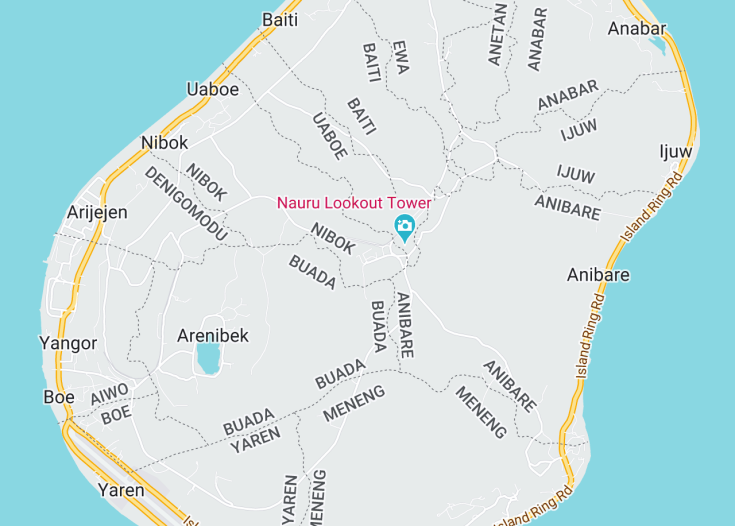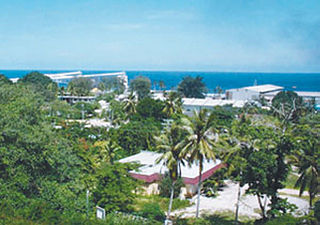Nauru, the third smallest nation by land area, is a hidden gem in the Pacific Ocean. This diminutive island country, perched northeast of Australia, boasts a unique tapestry of history, phosphate mining heritage, and an intricate Polynesian culture. The lush tropical backdrop, combined with captivating inland lakes and vibrant coral reefs, crafts an intriguing blend of natural allure and cultural depth. Travelers venturing to Nauru are welcomed with authentic experiences and an unspoiled paradise.
Time your visit with local festivities to immerse in Nauruan culture and savor local delicacies.
Exploring by bicycle is an ideal way to appreciate Nauru’s scenic beauty and small-town charm.
Top destinations in Nauru
Nauru: a hidden gem in the Pacific
| Capital | Rénoir |
| Time in Nauru | GMT+12:00 |
| Language spoken | Nauruan |
| Population | 10,670 (World Bank, 2020) |
| Religion | Congregational Christian Church in Nauru (76.7%), Roman Catholic (8.8%), Nauru Independent Church (7.9%), Other (6.6%) |
| Currency | Australian Dollar (AUD), AUD |
| Airports | Nauru International Airport |
Often referred to as the world’s third smallest country, Nauru is an island nation with an intriguing history and unique allure that captures the hearts of its visitors. Its isolation, combined with a landscape characterized by the phosphate rock outcrops, provides a distinct ambiance that stands apart from typical tropical paradises.
Nauru’s history is intertwined with its vast phosphate deposits. These deposits, now exhausted, were the country’s economic backbone during the 20th century, turning it momentarily into one of the richest nations per capita. But this boom was not without repercussions; the mining activities have rendered a large part of the island uninhabitable. However, the juxtaposition of its stark mined terrains with the serene beaches offers an unconventional but captivating experience for intrepid travelers.
The country’s historical sites, such as the remnants of the World War II, further add depth to a visit here. Japanese occupation during the war has left behind bunkers and relics, serving as poignant reminders of Nauru’s past. While it may not have the bustling resorts or long lists of attractions like some other destinations, Nauru offers a quiet, reflective experience. The simplicity of life, the warmth of the local people, and the opportunity to immerse oneself in an authentic Pacific island culture make Nauru a unique travel destination.
Fishing, diving, and exploring the coral reefs are among the leisure activities that visitors can indulge in. The marine life surrounding the island is vibrant and diverse, making it an underwater paradise for enthusiasts.
Where is Nauru located?
Nauru is a tiny island nation situated in the Pacific Ocean, northeast of Australia. It lies just south of the equator and is a part of the Micronesian subregion, surrounded by vast expanses of azure waters.
What is Nauru famous for?
Nauru is predominantly known for its rich phosphate deposits which once fueled its economy. Additionally, its status as one of the world’s smallest independent republics and unique post-World War II history makes it a point of intrigue for many.
History
Early Settlements: The First Inhabitants
Nauru’s first inhabitants are believed to have settled on the island around 3,000 years ago, arriving from the Pacific islands. Over time, these settlers developed a distinct Micronesian culture, with a language and traditions unique to the island. The island’s social structure consisted of 12 tribal groups, which are still recognized today in the 12-pointed star on Nauru’s national flag.
1798: European Discovery
The British sea captain John Fearn was the first European to sight Nauru in 1798. He named it “Pleasant Island” due to its appealing appearance. However, for most of the 19th century, Nauru remained relatively undisturbed by European influences, allowing its indigenous culture to thrive.
Late 19th Century to Early 20th Century: Colonial Era
In the late 19th century, Nauru became a target for European colonial ambitions. It was annexed by Germany in 1888 and integrated into its Pacific protectorate. The island remained under German control until World War I when the Allied forces captured it. After the war, Nauru became a League of Nations mandate under Australian administration, with New Zealand and the United Kingdom as co-trustees.
Mid 20th Century: Phosphate Mining and Japanese Occupation
During the early 20th century, the discovery of rich phosphate deposits transformed Nauru’s economic landscape. Extensive mining operations began, with Australia, New Zealand, and the UK benefitting from the extracted resources. However, the revenues did not significantly benefit the Nauruans. During World War II, Nauru faced occupation by Japanese forces from 1942 to 1945. The occupation had a profound impact, with almost two-thirds of the Nauruan population being deported to work as laborers in the Caroline Islands.
1968: Independence and Economic Prosperity
On January 31, 1968, Nauru achieved independence, becoming the world’s smallest independent republic. With the revenues from phosphate mining, Nauru enjoyed significant economic prosperity for a couple of decades. The country invested heavily abroad, aiming to secure a future for its citizens once the phosphate reserves were depleted.
Late 20th Century to Present: Economic Decline and Contemporary Challenges
By the close of the 20th century, Nauru’s phosphate reserves had significantly dwindled, leading to an economic downturn. The investments made abroad did not yield the expected returns, pushing Nauru into financial difficulties. In the 21st century, the country sought alternative revenue sources, including an agreement with Australia to house asylum seekers in detention centers on the island. Today, Nauru faces challenges related to its economic dependency, environmental degradation from past mining activities, and rising sea levels due to climate change.
Visit Nauru
What to see and do in Nauru
When visiting Nauru, there are several attractions and activities that showcase the island’s unique natural beauty and cultural heritage. Here are some recommendations:
- Visit Anibare Bay: This beautiful bay offers stunning views of the crystal-clear waters and sandy beaches. It’s a perfect spot for swimming, snorkeling, and relaxing.
- Explore Buada Lagoon: Located in the interior of the island, Buada Lagoon is a serene freshwater oasis surrounded by lush vegetation. Take a stroll around the lagoon and enjoy the peaceful ambiance.
- Learn about Nauruan culture: Visit the Nauru National Museum to gain insights into the island’s history, culture, and traditions. The museum houses artifacts and exhibits that provide a glimpse into Nauru’s past.
- Experience the nightlife: Nauru has a vibrant nightlife scene with various bars, clubs, and restaurants. Enjoy live music, dance performances, and delicious local cuisine.
- Take a scenic drive: Explore the island by taking a drive around its coast. Enjoy the picturesque views of the rugged coastline, coral reefs, and dramatic cliffs.
Events in Nauru
Nauru hosts various events throughout the year, showcasing its culture and traditions. The following are some notable events:
- Nauru Independence Day (January 31): Celebrated annually, Nauru Independence Day commemorates the country’s independence from Australia in 1968. Festivities include parades, cultural performances, and fireworks.
- Nauru Phosphate Royalties Day (October 25): This day honors the significance of phosphate mining in Nauru’s history. It is marked by ceremonies, traditional dances, and exhibitions.
- Nauru Sports Awards (December): Recognizing sporting achievements and contributions, the Nauru Sports Awards highlight the talents of local athletes in various disciplines.
Best time to visit Nauru
The best time to visit Nauru is during the dry season, which runs from April to October. This period offers pleasant weather with lower humidity and minimal rainfall. The temperatures are also milder, making outdoor activities more enjoyable.
It’s worth noting that Nauru has a tropical climate, so expect warm temperatures throughout the year. However, the wet season, from November to March, experiences higher precipitation and humidity, which can limit outdoor exploration.
Is Nauru worth visiting?
Nauru’s unique cultural heritage, breathtaking natural landscapes, and intriguing history make it a worthwhile destination for travelers seeking off-the-beaten-path experiences. The island offers opportunities to immerse oneself in a rich cultural tapestry and explore pristine beaches, lush interiors, and captivating underwater ecosystems.
However, it’s essential to acknowledge the challenges faced by Nauru, such as environmental degradation and economic instability. These issues may impact the overall travel experience. Additionally, Nauru’s remote location and limited tourism infrastructure can pose logistical challenges for visitors.
Overall, Nauru may not be a conventional tourist destination, but for those with an adventurous spirit and a curiosity for lesser-known destinations, it offers a chance to discover a unique and often overlooked corner of the world.
Common questions
What are the best things to do in Nauru?
- Explore the beautiful vegetation and wildlife at the Buada Lagoon
- Relax at the stunning Anibare Bay with its clear blue waters
- Visit the Command Ridge, a historic site with remnants from World War II
- Discover the intriguing Nauru History and Mining Museum
- Enjoy a day of swimming and snorkeling at the Moqua Well
- Take a walk along the scenic coastline at Denigomodu District
What is the local cuisine like in Nauru?
- Ika (raw fish marinated in lime or lemon juice)
- Bula (Nauruan coconut pudding)
- Fried breadfruit
- Taro chips
The local cuisine often features fresh seafood, coconuts, root vegetables, and tropical fruits. Don’t miss the chance to try these unique and delicious Nauruan dishes during your visit!
Are there any beautiful beaches in Nauru?
Can I go scuba diving in Nauru?
What is the weather like in Nauru?
Are there any hiking trails in Nauru?
What are the traditional arts and crafts of Nauru?
- Carving: Nauruan artisans create beautiful carvings from wood and stone, often depicting elements from nature and mythology.
- Tapa cloth: Tapa cloth is made from the bark of the paper mulberry tree and is decorated with intricate patterns. It is used for clothing, decorations, and ceremonial purposes.
- Shell jewelry: Nauruans have a long tradition of making jewelry from shells. Necklaces, bracelets, and earrings adorned with shells are popular traditional accessories.
Exploring the local markets and handicraft shops in Nauru will give you the opportunity to see and purchase these unique traditional arts and crafts.













